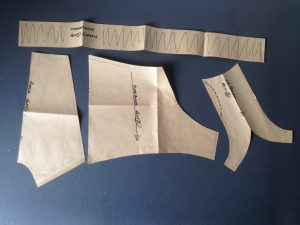How To Make Mens Underwear
Types Of Mens Underwear.
224. For beginners in mens under wear making, the first thing to know is that there are two distinct types of mens underwear, depending on the fabrics used in construction – Woven and stretch.
Each type is made in completely different ways, and require different pattern cutting methods, different sewing techniques, different machinery, and different sewing attachments and threads. This page is about making stretch underwear for men.
Mens Stretch Underwear Patterns.
As with all contour garments, mens underwear needs to be cut with comfort paramount. Seams, gussets and panels need to be precisely placed for maximum comfort. The contoured pouch needs to be just the right shape and size.
Most mens stretch underwear patterns are cut with a 1/4″ (.7 mm ) seam allowance, whether they are just overlocked, or flatstitched. Hems are normally 2cms wide.

Pattern for mans boxer brief
Mens underwear styles
Mens stretch underwear encompasses a variety of garment stlyles. Those styles include :-
- Briefs
- Low rise briefs
- High rise briefs
- Boxers
- Boxer briefs
- Y Fronts
- Trunks
- Jockstraps
- Longs
- G Strings
- Vests
- Singlets
Variations In Style
There are many variations in mens underwear design. Boxers may have an encased waistband with a fly opening, or a sewn on elastic waistband without a fly.
Modern briefs generally have a contour pouch with or without a centre front seam. Or they may have a traditional crossover fly.
There are a few recognised brands such as Calvin Klein, Jockey and Sloggi that have a large part of the market, and there have been a number of established designer brands jumping onto the band wagon.
Creating A Custom Pattern Block.
Beginners in garment making of any kind are often obsessed with drafting their own block patterns from a formula. But using a drafting formula is rarely a good idea for any type of garment unless you are a bespoke maker working with a wide variety of shapes and sizes. Even then, it takes a lot of experience to master the art of drafting patterns, and ensuring that they are accurate.
It is far better to draft your custom pattern using either an existing pattern, or a reference garment, just as an experienced pattern cutter would do. The drawback with bought shop patterns, is that they often don’t use the correct seam allowances, and you don’t know what shape or size you are getting until it is sewn up.
There are a number of real advantages with creating your pattern from a garment. Firstly, you can see what size and shape the garment is without any trial and error, although you do have to accurately create the pattern. Secondly, you learn much more when you have to copy a pattern, than either drafting, or using an existing pattern.
It’s not easy creating a pattern from a knitted garment, as the fabric is not stable, and the garment is often distorted by elastication. It is always better wherever possible, to use a check or striped garment So that you have a ready made grid to work from.
An experienced pattern cutter shouldn’t have to cut the garment up in order to make a pattern, but a beginner may have to. However you do it, you need to pin each piece of the garment to your paper, making sure that you don’t over or under stretch the fabric.
Flatstitch Seams.
Flatstitch is essential for many types of underwear and sportswear construction. It is a seam that joins two pieces of fabric together by butting the two edges together and oversewing with a zig-zag stitch.
This allows the seam to lay flat, providing more comfort for the wearer. It also provides for high seam elongation, which means it can be stretched without breaking.
Coverstitch Hems.
Coverstitch hems are used extensively in underwear and sporstswear. It provides a professional finish for raw seams, allowing for a great amount of stretch to hems without breaking the stitching.
The coverstitch gives a twin needle top stitch finish on the outside, while covering the inside fabric edge with a zig-zag overlock stitch.
A bulk thread is often used to provide more comfort and greater coverage. This is a wooly thread that fluffs out
Waistbands.
There are three main types of waistband used in mens underwear production :-
The encased elastic waistband, found mainly in boxers and finer fabrics.
Sewn inside the waist so that it appears to be encased, but the elastic is exposed.
Sewn on elastic. This is often knitted with a brand logo.
The Fly.
Apart from the obvious function, a fly adds some shaping, and an element of design to mens briefs. It also aids in shaping the area. There are three basic type of fly – The standard vertical fly, the horizontal fly, and the Y-front fly.
Mens Underwear Pattern Making Work shop.
If you are interested in learning how to cut mens underwear underwear, then take a look at our
mens underwear pattern cutting workshop.
EMAIL [email protected]
